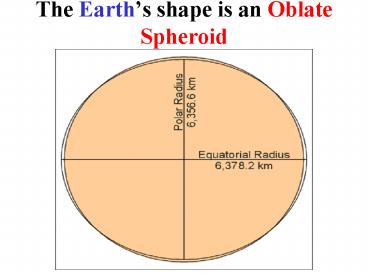The Earths shape is an Oblate Spheroid - PowerPoint PPT Presentation
1 / 12
Title:
The Earths shape is an Oblate Spheroid
Description:
... an oblate ellipsoid or geoid (which simply means 'earth ... This shape is known as an ellipsoid or more properly, geoid (earth-like). From Matt Rosenberg ... – PowerPoint PPT presentation
Number of Views:686
Avg rating:3.0/5.0
Title: The Earths shape is an Oblate Spheroid
1
The Earths shape is an Oblate Spheroid
2
What is an Oblate Spheroid?It is a sphere with
a slight flattening at the polar regions and a
slight bulging at the equatorial
region.Definition The earth is shaped not as a
sphere but as an oblate ellipsoid or geoid (which
simply means "earth shaped.") The earth is widest
at the equator due to gravity and rotation. The
earth is 24,901.55 miles around at the equator
and 24,859.82 miles between the North and South
Poles. The difference between the two is 41.73
miles, so the earth is 41.73 miles wider than it
is tall.
3
Eratosthenes
- (276 - 195 B.C.)
4
Eratosthenes
- Greek scholar
- called the "father of geography
- educated at the academies of Athens
- Appointed to run the Great Library at Alexandria
in 240. - He served as the director of the famous library
in Alexandria.
5
- Having discovered in his reading that a deep
well at Syene (near the Tropic of Cancer and
modern Aswan) where sunlight only struck the
bottom of the well on the summer solstice,
Eratosthenes determined that he could discover
the circumference of the earth. - Eratosthenes measured the altitude of the
noontime sun at Alexandria at its maximum on Jun
21st.
6
(No Transcript)
7
- On that date, the Sun is directly overhead at
noontime at Syene, in southern Egypt (latitude
23.5 degrees north). - The zenith distance is the angle from the zenith
to the point where the Sun was at noon it is
also 90 degrees minus the altitude. - At Syene, the zenith distance was 0 degrees at
Alexandria it was about 7 degrees. - He knew how far it was from Alexandria to Syene,
so he used geometry and the difference in zenith
angle to estimate the size of the Earth. - Eratosthenes also measured the tilt of the Earth
axis by 23.5 degrees, which gives us the seasons
.
8
(No Transcript)
9
(No Transcript)
10
- In the 17th century, Isaac Newton deduced from
theoretical considerations that the Earth was
slightly flattened at the poles and bulged
slightly at the Equator, due to the Earth's
rotation on its axis. - This was subsequently confirmed by field
observations. - The Earths equatorial radius is approximately 22
km longer than its polar radius. - One consequence of this is that the length of one
degree of latitude varies slightly depending on
the distance from the Equator or the poles.
11
(No Transcript)
12
- The circumference of the earth at the equator is
24,901.55 miles (40,075.16 kilometers). - But, if you measure the earth through the poles
the circumference is a bit shorter - 24,859.82
miles (40,008 km). - This the earth is a tad wider than it is tall,
giving it a slight bulge at the equator. - This shape is known as an ellipsoid or more
properly, geoid (earth-like). - From Matt Rosenberg































